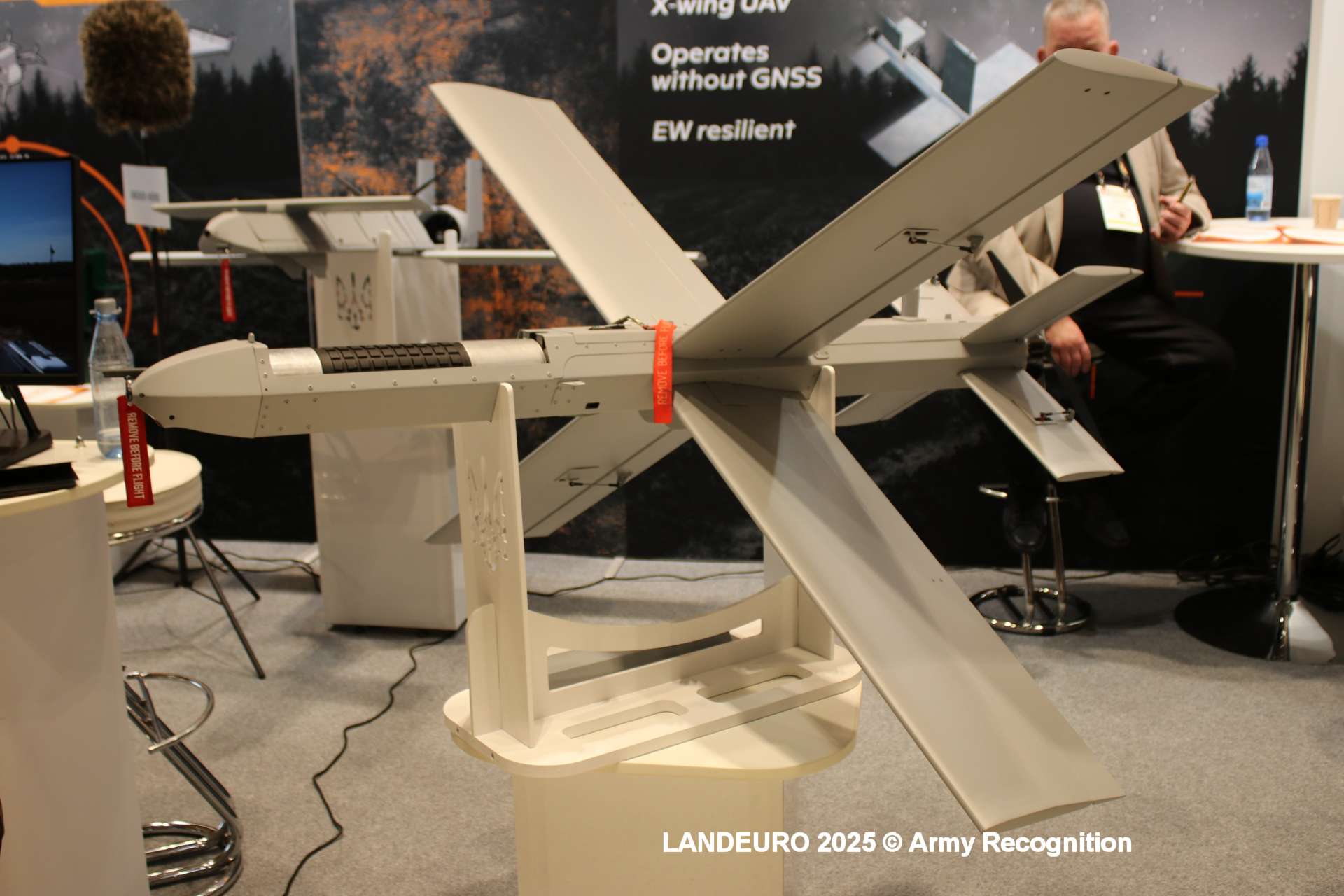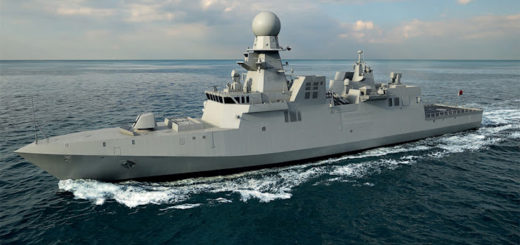Ukraine’s OCTAVA Defence’s Flycat Drone Debut at LANDEURO 2025 Signals New Era of Smart Loitering Munitions

{loadposition bannertop}
{loadposition sidebarpub}
On July 16, 2025, Ukraine’s OCTAVA Defence showcased its innovative Flycat ground target engagement system during LANDEURO 2025 in Wiesbaden, Germany, marking a significant milestone in the evolution of smart loitering munitions. Designed amid the growing need for resilient battlefield solutions, Flycat draws attention for its autonomous features that directly address modern electronic warfare challenges. The system’s reveal highlights Ukraine’s rapidly advancing defence industry and underlines the increasing role of indigenous drone systems in shaping European security. Its relevance lies not only in its technical performance but also in the geopolitical weight it carries at a time of ongoing regional tensions.Follow Army Recognition on Google News at this link
The debut of Flycat at LANDEURO 2025 serves as a clear indicator that Ukraine’s defence sector is ready to move from adaptation to leadership in smart drone warfare (Picture source: Army Recognition Group)
Flycat is engineered as a smart kamikaze drone that can autonomously loiter, identify, and engage ground targets without relying on satellite navigation, a critical advantage in jammed or denied environments. Shaped like a missile with distinctive X-shaped wings, the drone boasts agility across all axes, delivering precise strikes with warheads ranging from 2.5 to 3.6 kilograms, available in thermobaric, cumulative, or high-explosive configurations. Its electric propulsion ensures a flight duration of up to 40 minutes over a range of 40 kilometres, while its compact design and pneumatic catapult launch system allow for rapid deployment with just 20 minutes of preparation.
OCTAVA Defence developed Flycat by closely studying the limitations faced by previous loitering munitions in Ukraine’s operational theatres, particularly their susceptibility to GPS jamming. By integrating intelligent navigation and secure communication guidance modules, Flycat circumvents this Achilles’ heel. Drawing lessons from earlier models like the Israeli Harpy or the Russian Lancet, Flycat combines similar loitering endurance with enhanced autonomy and resilience. Its X-wing aerodynamic scheme distinguishes it from conventional aircraft-type drones, offering superior manoeuvrability and strike accuracy in cluttered battlefields.
A critical advantage of Flycat lies in its hybrid role as both a tactical precision strike asset and an element of larger reconnaissance networks. Unlike many similar drones still reliant on satellite signals, Flycat’s ability to operate fully autonomously makes it especially valuable in contested electromagnetic environments. Compared to historical systems like the Harop or Switchblade series, Flycat’s modular warhead options and launch readiness provide greater operational flexibility and faster response times, while its electric propulsion aligns with evolving sustainability requirements in modern military doctrines.
The strategic implications of Flycat’s deployment are significant for Ukraine and its allies. Its GPS-independent guidance directly counters electronic warfare dominance efforts by adversaries, strengthening Ukraine’s deterrence posture along contested frontlines. Furthermore, the export potential of Flycat could reshape regional drone markets, positioning Ukraine not just as a consumer but as a competitive supplier of smart loitering munitions within Europe and beyond. Such a shift holds broader geopolitical resonance, signaling the country’s commitment to self-reliant, tech-driven defence capabilities at a time when the European security architecture is under intense strain.
The debut of Flycat at LANDEURO 2025 serves as a clear indicator that Ukraine’s defence sector is ready to move from adaptation to leadership in smart drone warfare. As the demand for resilient, autonomous loitering munitions increases, systems like Flycat not only promise tactical superiority but also stand as powerful symbols of a nation’s technological resolve to counter modern threats on its own terms.
{loadposition bannertop}
{loadposition sidebarpub}
On July 16, 2025, Ukraine’s OCTAVA Defence showcased its innovative Flycat ground target engagement system during LANDEURO 2025 in Wiesbaden, Germany, marking a significant milestone in the evolution of smart loitering munitions. Designed amid the growing need for resilient battlefield solutions, Flycat draws attention for its autonomous features that directly address modern electronic warfare challenges. The system’s reveal highlights Ukraine’s rapidly advancing defence industry and underlines the increasing role of indigenous drone systems in shaping European security. Its relevance lies not only in its technical performance but also in the geopolitical weight it carries at a time of ongoing regional tensions.
Follow Army Recognition on Google News at this link
The debut of Flycat at LANDEURO 2025 serves as a clear indicator that Ukraine’s defence sector is ready to move from adaptation to leadership in smart drone warfare (Picture source: Army Recognition Group)
Flycat is engineered as a smart kamikaze drone that can autonomously loiter, identify, and engage ground targets without relying on satellite navigation, a critical advantage in jammed or denied environments. Shaped like a missile with distinctive X-shaped wings, the drone boasts agility across all axes, delivering precise strikes with warheads ranging from 2.5 to 3.6 kilograms, available in thermobaric, cumulative, or high-explosive configurations. Its electric propulsion ensures a flight duration of up to 40 minutes over a range of 40 kilometres, while its compact design and pneumatic catapult launch system allow for rapid deployment with just 20 minutes of preparation.
OCTAVA Defence developed Flycat by closely studying the limitations faced by previous loitering munitions in Ukraine’s operational theatres, particularly their susceptibility to GPS jamming. By integrating intelligent navigation and secure communication guidance modules, Flycat circumvents this Achilles’ heel. Drawing lessons from earlier models like the Israeli Harpy or the Russian Lancet, Flycat combines similar loitering endurance with enhanced autonomy and resilience. Its X-wing aerodynamic scheme distinguishes it from conventional aircraft-type drones, offering superior manoeuvrability and strike accuracy in cluttered battlefields.
A critical advantage of Flycat lies in its hybrid role as both a tactical precision strike asset and an element of larger reconnaissance networks. Unlike many similar drones still reliant on satellite signals, Flycat’s ability to operate fully autonomously makes it especially valuable in contested electromagnetic environments. Compared to historical systems like the Harop or Switchblade series, Flycat’s modular warhead options and launch readiness provide greater operational flexibility and faster response times, while its electric propulsion aligns with evolving sustainability requirements in modern military doctrines.
The strategic implications of Flycat’s deployment are significant for Ukraine and its allies. Its GPS-independent guidance directly counters electronic warfare dominance efforts by adversaries, strengthening Ukraine’s deterrence posture along contested frontlines. Furthermore, the export potential of Flycat could reshape regional drone markets, positioning Ukraine not just as a consumer but as a competitive supplier of smart loitering munitions within Europe and beyond. Such a shift holds broader geopolitical resonance, signaling the country’s commitment to self-reliant, tech-driven defence capabilities at a time when the European security architecture is under intense strain.
The debut of Flycat at LANDEURO 2025 serves as a clear indicator that Ukraine’s defence sector is ready to move from adaptation to leadership in smart drone warfare. As the demand for resilient, autonomous loitering munitions increases, systems like Flycat not only promise tactical superiority but also stand as powerful symbols of a nation’s technological resolve to counter modern threats on its own terms.







